Email template library: 25+ business email templates and outlines
A wide range templates to improve your email outreach plus best practices for using and optimizing email templates.
Nonprofit organizations face unique challenges when it comes to fundraising. Limited resources and the need for constant financial support demand efficient and effective donor engagement strategies. Email communication offers a powerful solution.
To empower nonprofits in their fundraising efforts, we've curated a collection of professionally designed email templates. Tailored to the needs of nonprofits, these templates enable you to deliver impactful messages and build meaningful connections with donors.
Our user-friendly templates, customizable to fit your goals, save time and effort. They cover various fundraising scenarios, from donation requests to sharing impact reports. Additionally, we'll provide tips and best practices for maximizing email campaign effectiveness.
Ready to supercharge your nonprofit email fundraising efforts?
Let's explore our collection of ready-to-use email templates and empower your nonprofit to make an even greater difference.
Visit our email template library to find email templates for more business cases.
These 8 email templates will help you manage your contacts and donor base while you grow your fundraising efforts.
Head over to the email template library to find a copy and paste version of each template.
<div class="anchor-wrapper"><div id="welcome-email" class="anchor-target"></div></div>
These emails are generally one of the donors' first impressions of your organization.
A “thank you for signing up” email is essential to start your relationship on the right foot – it also lets them know they typed in their email correctly.
Here’s a standard “welcome” email:
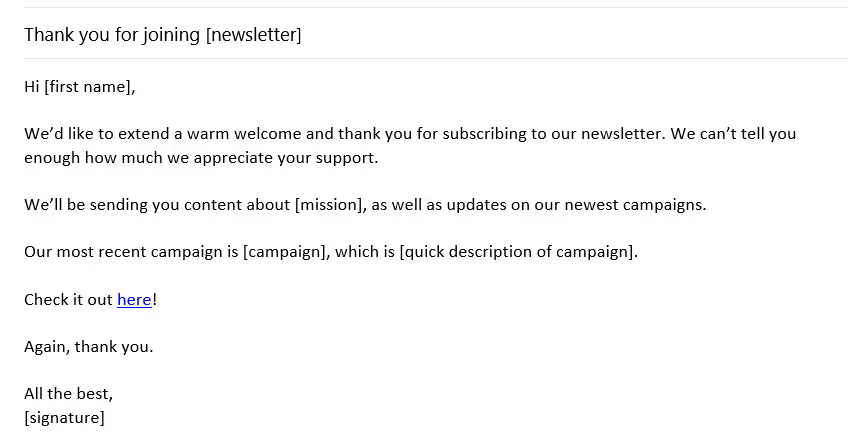
This email doesn’t have to be complicated. The general formula will be:
Short, sweet, and concise.
<div class="anchor-wrapper"><div id="progress-update" class="anchor-target"></div></div>
You can use this email to educate your supporters on your mission, activities, and ongoing campaigns.
It’s a good idea to list recent achievements, funds raised, and anything countable or tangible – like “We’ve built X schools.”

This is a great fundraising email to educate supporters and spur them to become donors – and pre-existing donors will appreciate seeing an update on your activities.
<div class="anchor-wrapper"><div id="donation-individuals" class="anchor-target"></div></div>
Requesting help from your individual supporters is critical in your fundraising campaign, but “critical” doesn’t mean “complicated.”
Here’s a simple template to send to individual donors:
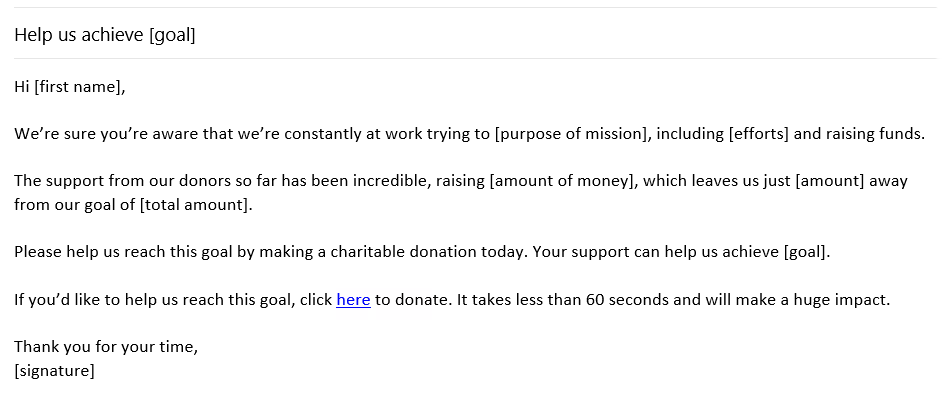
<div class="anchor-wrapper"><div id="donation-businesses" class="anchor-target"></div></div>
A donation request to another business will be different from an individual request in a few key ways.
Take a look at our template to request donations from companies:
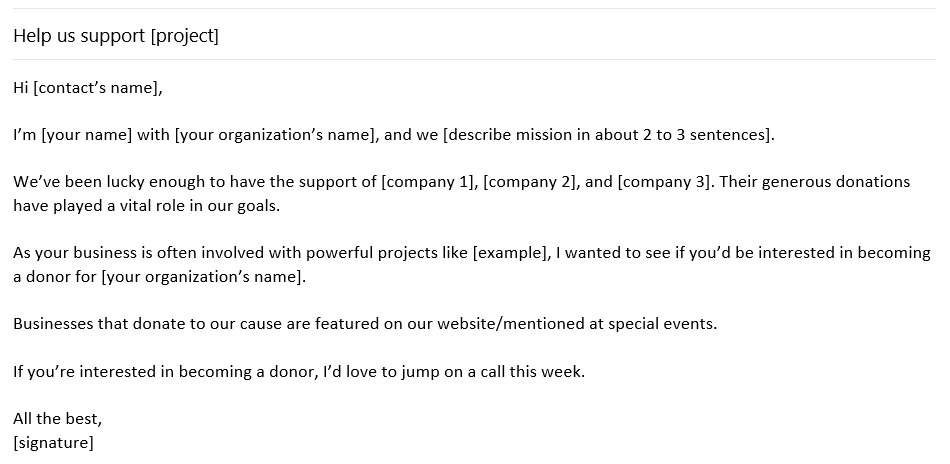
It’s important to talk about other businesses that support you and bring up any charitable work the target company has done in the past. It brings more value and context to your email.
The request for a video call is unique, too. Donations from businesses are larger, and it’s often a good idea to talk personally.
<div class="anchor-wrapper"><div id="share-network" class="anchor-target"></div></div>
Your donors’ friends and family are a wonderful source of support for your organization.
Someone who may never have considered donating might take the leap if a loved one asks them.
Let’s take a look at what that template would look like:
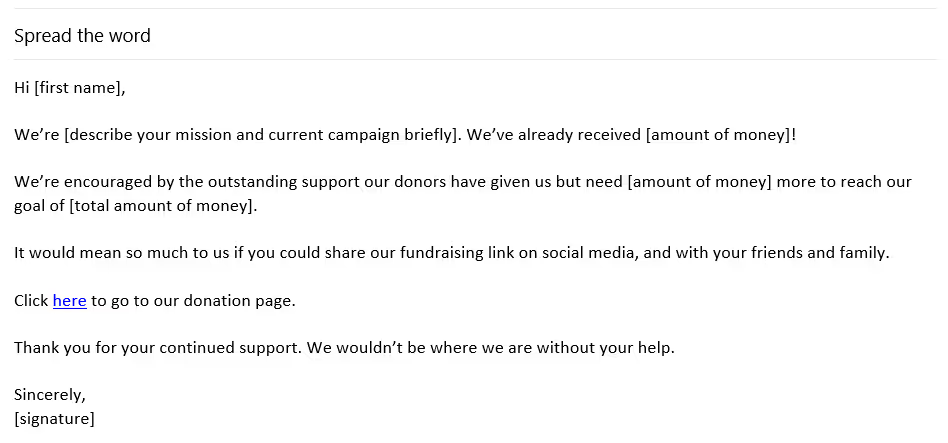
When your supporters tell family and friends and share your donation link via social media, it extends your message through channels you may never have reached otherwise.
<div class="anchor-wrapper"><div id="impact-report" class="anchor-target"></div></div>
Showing the impact a donor has on your project is essential.
One survey showed that the top two factors that encouraged people to donate to nonprofits are transparency about what donations are spent on and learning about a nonprofit’s impact.
This email aims to accomplish both.
Here’s a quick example:
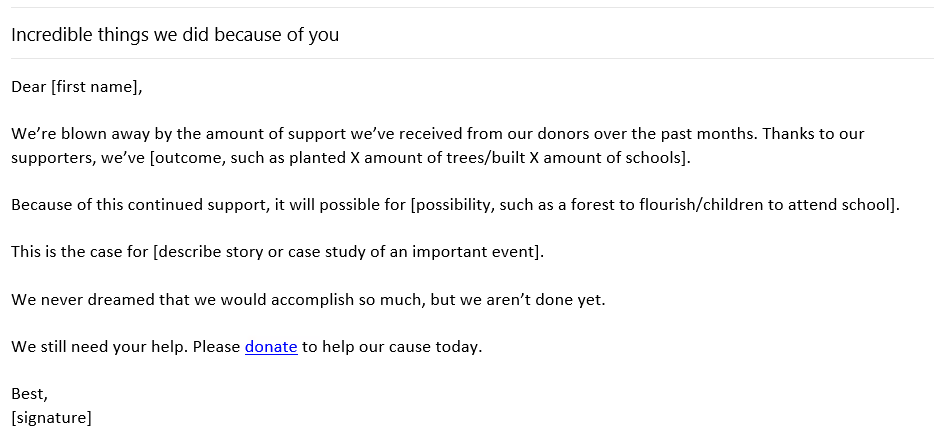
<div class="anchor-wrapper"><div id="thank-you-donation" class="anchor-target"></div></div>
After someone donates, sending a follow-up “thank you” is critical.
You want to show gratitude for every donation – no matter the size.
Here’s an example “thank you” email template:

This type of email makes the donor feel valued and like they’re making a difference. It also lets them know you successfully received their donation.
<div class="anchor-wrapper"><div id="periodic-report" class="anchor-target"></div></div>
This email’s purpose is to relay key insights from your impact report, then provide a link to the report itself.
This helps create transparency on your mission’s progress and report key achievements.
Here’s what that email might look like:
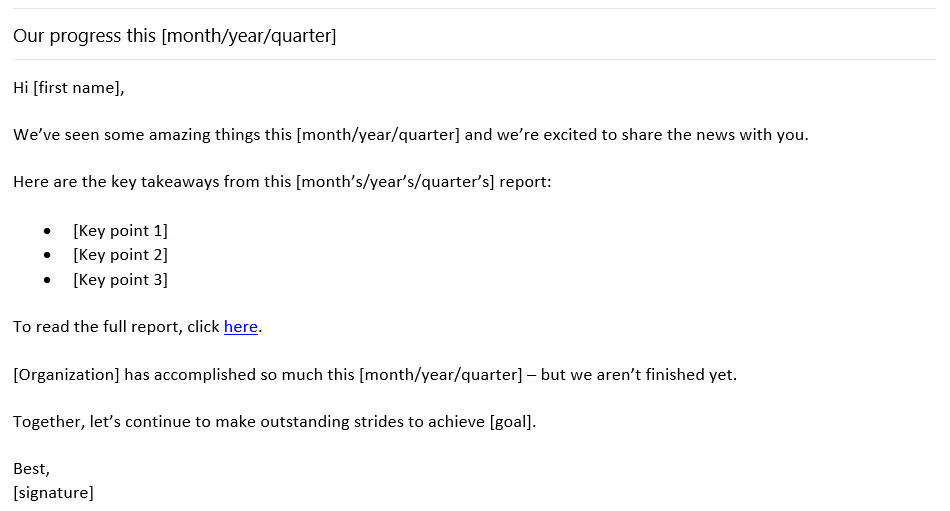
<div class="anchor-wrapper"><div id="successful-campaign" class="anchor-target"></div></div>
An email fundraising campaign is a powerful tool for non-profit organizations to collect donations and cultivate support from their audience.
These key elements will help ensure your fundraising campaign’s success:
Building a robust contact database is essential. Maintain an updated list of engaged supporters, donors, and potential donors. Regularly clean and segment your contacts for targeted communication.
Tailoring your emails to specific donor segments increases the relevance and impact of your messages.
Consider factors such as donation history, interests, or engagement level to create personalized content that resonates with each segment. Track these attributes in a CRM to quickly identify who should be included in each donor segment.
The subject line is your email's first impression. Craft a compelling subject line that grabs attention, evokes curiosity, and entices recipients to open your email. Experiment with different approaches and monitor open rates to optimize your subject lines.
Connect emotionally with your audience by sharing a compelling narrative that highlights your organization's impact and the lives it touches. Use storytelling techniques to engage readers and create a sense of urgency around your cause.
Clearly communicate the desired action you want recipients to take. Whether it's making a donation, attending an event, or sharing your message, a strong call-to-action motivates and guides your supporters towards meaningful involvement.
Additionally, continuous improvement is crucial for maximizing campaign performance. By tracking key email marketing metrics and analyzing data, you can gain valuable insights.
Compare different email campaigns, evaluate open and click-through rates, measure conversion rates, and analyze engagement patterns to identify areas for optimization.
Remember, leveraging data to inform your decisions and strategies can significantly enhance the effectiveness of your email fundraising campaigns. By monitoring and learning from past performance, you can refine your approach and achieve even greater results in mobilizing support for your non-profit organization.
